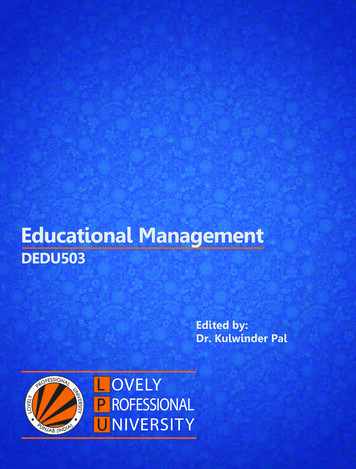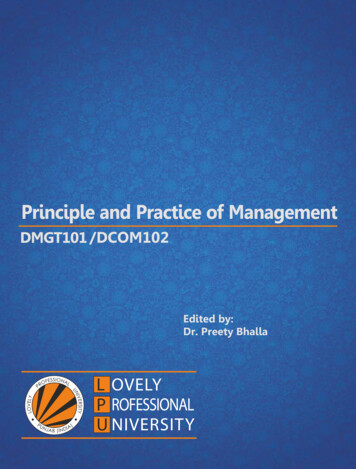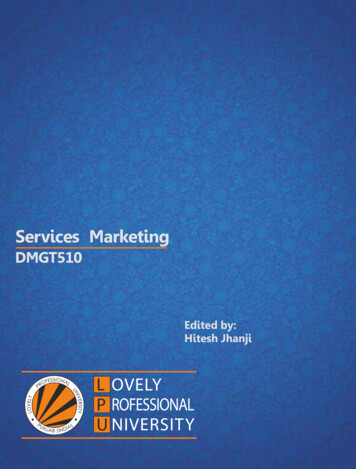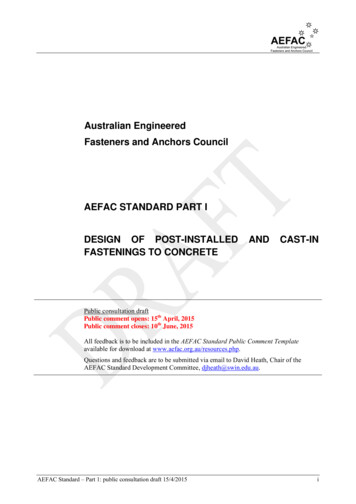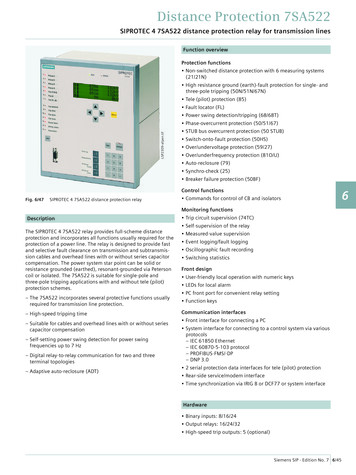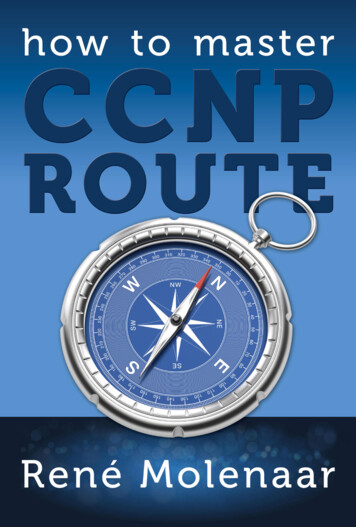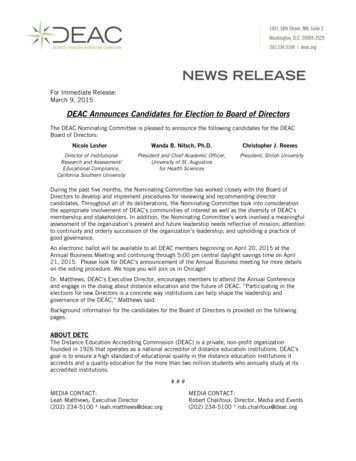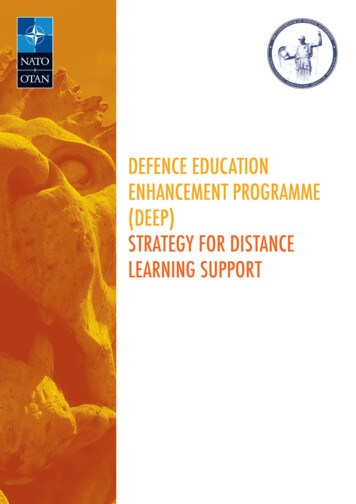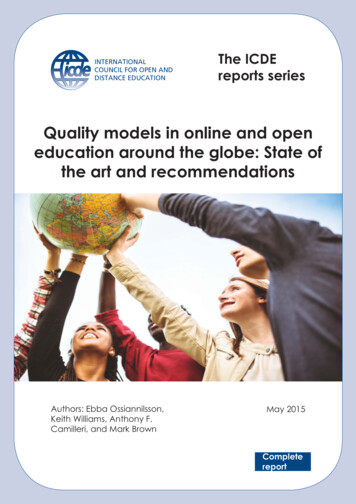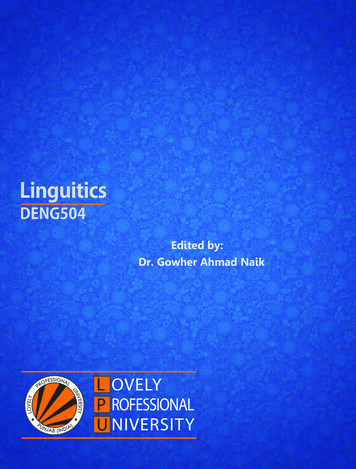
Transcription
LinguiticsDENG504Edited by:Dr. Gowher Ahmad Naik
LINGUISTICSEdited ByDr. Gowher Ahmad Naik
Printed byUSI PUBLICATIONS2/31, Nehru Enclave, Kalkaji Ext.,New Delhi-110019forLovely Professional UniversityPhagwara
SYLLABUSLinguisticsCourse Objectives: To introduce the student to the tools, branches, and history of Linguistics To improve and enhance student’s pronunciation and language skills To improve the proficiency of the student in the correct usage of English Vocabulary.Sr.ContentNo.1Introduction to Linguistics: Its Aspects, Linguistics: Branches and Tools, Brief Historyof the Growth of Modern Linguistics: Bloomfield and Chomsky2Phonetics: Speech Mechanism, Places and Manners of Articulation; Classification ofSpeech Sounds: Vowels, Consonants- General Introduction3Consonants and its Phonetic Transcription, Vowels and its Phonetic Transcription,Diptholongs and its Phonetic Transcription4Clusters and Syllables, Phoneme: Detailed Study, Allophones: Allophonic variation inEnglish Speech: Difference between Monoptholong and Diptholong Glides;Transcription of English Speech Sounds: From words to sentences, Syllables : Monosyllabic, Bi- syllabic and stress in English5Branches in Linguistics: Socio-Linguistics, Psycho-Linguistics, EducationalLinguistics6Varieties of English Cardinal Vowel System, Connected English Speech Accent,Rhythm, Discourse, Difference in R.P. and Indian English7Morphology: Morph, Morpheme, Allomorph; Morphological Analysis (Identificationof Morphemes and Allomorphs)8Word Formation: Process, Rules, Derivation and Inflection; Transformational Rules:Application-Tree Diagrams9Affixes: Prefixes, Suffixes, Infixes and Circumfixes; Grammar Traditional toTransformational; Transformational Generative Grammar; Transformational and PhraseStructure Rules10Language Teaching Analysis, Contrastive Analysis, Error Analysis: SemanticMeaning Types: Lexical, Contextual and other Semantic Practice; Synonymy,
CONTENTSUnit 1:Introduction to Linguistics: Its AspectsUnit 2:Linguistics: Branches and Tools1Digvijay Pandya, Lovely Professional University13Gowher Ahmad Naik, Lovely Professional UniversityUnit 3:Brief History of the Growth of Modern Linguistics: Bloomfield to Chomsky24Gowher Ahmad Naik, Lovely Professional UniversityUnit 4:Phonetics: Speech Mechanisms-Places and Manners of Articulation43Digvijay Pandya, Lovely Professional UniversityUnit 5:Classification of Speech Sounds: Vowels, Consonants-General IntroductionUnit 6:Consonants and its Phonetic Transcription51Digvijay Pandya, Lovely Professional University74Gowher Ahmad Naik, Lovely Professional UniversityUnit 7:Vowels and Its Phonetic Transcription83Gowher Ahmad Naik, Lovely Professional UniversityUnit 8:Diphthongs and its Phonetics Transcription94Gowher Ahmad Naik, Lovely Professional UniversityUnit 9:Clusters and Syllables103Digvijay Pandya, Lovely Professional UniversityUnit 10:Phonemes: Detailed Study118Digvijay Pandya, Lovely Professional UniversityUnit 11:Allophones–Allophonic Variation in English Speech:Difference between Monopthong and Diphthong Glides146Gowher Ahmad Naik, Lovely Professional UniversityUnit 12:Transcription of English Speech Sounds: From Words to Sentences, Syllables:Monosyllabic, Bi-syllabic and Stress in English161Gowher Ahmad Naik, Lovely Professional UniversityUnit 13:Branches in Linguistics: Socio-Linguistics177Gowher Ahmad Naik, Lovely Professional UniversityUnit 14:Branches in Linguistics: Psycho-LinguisticsUnit 15:Branches in Linguistics: Educational Linguistics188Digvijay Pandya, Lovely Professional University194Digvijay Pandya, Lovely Professional UniversityUnit 16:Varieties of English Cardinal Vowel SystemGowher Ahmad Naik, Lovely Professional University206
Unit 17:Connected English Speech: Accent225Digvijay Pandya, Lovely Professional UniversityUnit 18:Rhythm243Digvijay Pandya, Lovely Professional UniversityUnit 19:Discourse257Gowher Ahmad Naik, Lovely Professional UniversityUnit 20:Difference in R.P. and Indian English272Digvijay Pandya, Lovely Professional UniversityUnit 21:Morphology: Morph, Morpheme, Allomorph279Gowher Ahmad Naik, Lovely Professional UniversityUnit 22:Morphological Analysis (Identification of Morphemes and Allomorph)289Digvijay Pandya, Lovely Professional UniversityUnit 23:Word-Formation: Process and Rules304Digvijay Pandya, Lovely Professional UniversityUnit 24:Word-Formation: Derivation, Inflection310Gowher Ahmad Naik, Lovely Professional UniversityUnit 25:Transformational Rules: Application-Tree Diagrams318Gowher Ahmad Naik, Lovely Professional UniversityUnit 26:Affixes: Prefixes, Suffixes, Infixes and Circumfixes326Digvijay Pandya, Lovely Professional UniversityUnit 27:Grammar: Traditional to Transformational334Gowher Ahmad Naik, Lovely Professional UniversityUnit 28:Transformational Generative Grammar346Digvijay Pandya, Lovely Professional UniversityUnit 29:Transformational and Phrase Structure Rules369Digvijay Pandya, Lovely Professional UniversityUnit 30:Language Teaching Analysis: Contrastive Analysis, Error Analysis383Digvijay Pandya, Lovely Professional UniversityUnit 31:Semantic: Meaning Types: Lexical, Contextual and Others Semantics Practice391Gowher Ahmad Naik, Lovely Professional UniversityUnit 32:Synonymy, Antonymy, Polysemy, Homophony and AmbiguityGowher Ahmad Naik, Lovely Professional University403
Digvijay Pandya, Lovely Professional UniversityUnit 1: Introduction to Linguistics: Its AspectsUnit 1: Introduction to Linguistics: Its AspectsNotesCONTENTSObjectivesIntroduction1.1 Is Linguistics a Science?1.2 The Scope of Linguistics1.3 Linguistic Levels1.4 Some Major Linguistic Concepts1.5 Summary1.6 Key-Words1.7 Review Questions1.8 Further ReadingsObjectivesAfter studying this Unit students will be able to: Understand Linguistic and its Aspects. Discuss the Scope of Linguistics.IntroductionThe word ‘Linguistics’ has been derived from Latin lingua (tongue) and istics (knowledge orscience). Etymologically, therefore, linguistics is the scientific study of language. But it is the studynot of one particular language but of human language in general. It studies language as a universaland recognizable part of human behaviour. It attempts to describe and analyze language. Thefield of linguistics comprises understanding of the place of language in human life, the ways inwhich it is organized to fulfil the needs it serves, and the functions it performs.So linguistics is that science which studies the origin, organisation, nature and development oflanguage descriptively, historically, comparatively and explicitly, and formulates the general rulesrelated to language. Diachronic (historical) linguistics studies the development of language throughhistory, through time, for example, the way in which French and Italian have evolved from Latin.Synchronic linguistics investigates how the people speak and use language in a given speechcommunity at a given time. In Comparative linguistics one is concerned with comparing two ormore different languages.Linguistics, therefore, is the science that describes and classifies languages. The linguist identifiesand describes the units and patterns of the sound system, the words and morphemes, and thephrases and sentences, that is the structure of language, as completely, accurately, and economicallyas possible.1.1 Is Linguistics a Science?Linguistics is the scientific study of language. Like all other sciences linguistics has a well-definedsubject matter, viz. natural languages, living or dead; it employs careful methods to observe,record and analyse the various phenomena related to its subject matter and hopes to presentunprejudiced, objective and verifiable descriptions. The approach and methodology of linguisticsis scientific. It is as inductive as a science could be, and is based on observations, formation ofLOVELY PROFESSIONAL UNIVERSITY1
LinguisticsNoteshypothesis, testing, verification, tentativeness and predictiveness. Like a scientist a linguist observeshis data. Some of his methods of observation include simple listening, phonetic transcription, andthe use of various instruments, such as oscillograph, sounds pectograph, kymograph, chromograph,mingograph, laryngoscope, endoscope, sonograph, autophonoscope, breathing flask,strobolaryngoscope, electric vocal tract, pitchmeter, intensity meter, speech stretcher, formantgraphing machine, etc. Records and cassettes made in these ways help in various kinds of objectivedescription. A linguist has his language laboratory too.Again, like a scientist a linguist develops hypotheses, makes generalized statements and teststhemagainst the fact of languages. When a linguist or a phonetician makes a statement about languages,he makes it on the basis of observation. First he observes linguistic events. He finds some similaritiesand contrasts on the basis of which he makes sound generalizations. On the basis of thesegeneralizations hypotheses are formulated to account for the events. These are tested by furtherobservations, and out of them is constructed a theory of how language works. From the theory arederived methods for making statements about linguistic events. The statements link the theory tothe events it is set up to account for, and they can now be evaluated by reference both to the theoryand to the events: the best statements are those which make maximum use of the theory to accountmost fully for the facts.The linguist also hopes to be in position to make prediction about unobserved linguistic data onthe basis of those observed, and build a general theory which would explain and relate all the factsto be found in individual languages. Predictions about grammars and dictionaries can be made byhim. And finally like a true scientist, he is constantly engaged in discovering more about languages,in refining his methods of investigation, and in constructing better theories. He also tries to findout linguistic universals.Like any scientific discipline, linguistics too is not static. Viewpoints and theoretical methods inthe field, change even in fundamental ways from time to time, and different aspects come toreceive primary focus at different times. Linguistics has more than its share of unresolvedcontroversies and unsolved questions, which is a part of its fascination and challenge.Finally, the closeness of Linguistics with other natural sciences like mathematics, physics,physiology, biology, zoology, etc., is another proof of its scientific nature. ‘It touches on physicsthrough acoustics, on physiology through the structure of the human vocal organs, on zoologythrough the comparative study of the communicative systems of living beings.’ A glance on anybook on transformational-generative grammar would convince any objective onlooker howlinguistics is becoming more and more scientific. Furthermore, as mentioned by R. H. Robins,linguistics in its operations and statements is guided by three canons of science:(1) exhaustiveness, the adequate treatment of all the relevent material; (2) consistency, the absenceof contradiction between different parts of the total statement, and within the limits imposed bythe two preceding principles; and (3) economy, whereby, other things being equal, a shorterstatement or analysis employing fewer terms is to be preferred to one that is longer or moreinvolved. Consequently, linguistics is getting more and more technical and sophisticated everyday. Yet it is not a pure science. Its position, says R. A. Hall, is between the natural and socialsciences, like that of geology. To Robins it is an ‘empirical science’, and within the empiricalsciences it is ‘one of the social sciences’, because its subject matter concerns human beings, and isvery much different from that of natural sciences.Nevertheless, linguistics is the scientific study of language. It may be inductive or deductive; it is,however, objective, precise, tentative and systematic; it is concerned with reportable facts, methods,and principles; it works by means of observations, hypotheses, experiments and tests, postulates,and inferences; it makes generalization and predictions; it formulates theories; its products aredescriptive, verbal or algebraic statements about language.1.2 The Scope of LinguisticsWe have discussed the definition and nature of linguistics. The question that arises immediatelynow is: what areas and what aspects of language study is the linguist interested in? In a broad2LOVELY PROFESSIONAL UNIVERSITY
Unit 1: Introduction to Linguistics: Its Aspectsway language is the expression of human thought, and all thought is expressed through language,hence all knowledge of the universe may fall within the scope of linguistics, and the scope may bea complex mess.NotesFigure 1.1Yet linguistics being a science, has got to be a systematic discipline. So the questions: what kind ofbehaviour does the linguist want to investigate? or what is the scope of linguistics?—need to beanswered. A linguist has to study and describe language which is an enormously complexphenomenon. He, therefore, concentrates at any one time on one of the many different, thoughinterrelated, aspects of his subject matter. His subject matter, broadly speaking, is the data oflanguage, or the facts of language as it is spoken and written.A full understanding of the various components of language and their relations with the rest ofthe world outside language, thus, would constitute the right scope of linguistics, which can roughlybe represented by the figure 1.2 borrowed from Jean Aitchison:PSYCHOLOGYI C SSLIN PHGU YINGACHTEN TAND PHONETICS GEMGUINO SHC T PHILOSOPHYLITERATUREFigure 1.2Thus general linguistics covers a wide range of topics and its boundaries are difficult to define. Inthe centre is phonetics, the study of human speech sounds. A phonetician is concerned with theLOVELY PROFESSIONAL UNIVERSITY3
LinguisticsNotesactual physical sounds, the raw material out of which language is made. He studies the positionof the tongue, teeth and vocal cords during the production of sounds, and records and analysessound waves. Around the central core are various branches of linguistics which are being rapidlydeveloped at the present time: such as psycholinguistics, sociolinguistics, mathematical linguistics,philosophical linguistics, anthropological linguistics, stylistics and language teaching.Phonology (sound patterning), grammar and semantics, (meaning) are the breadand butter of linguistics. They are the core of linguistics.1.3 Linguistic LevelsBy ‘linguistic levels’ is meant the levels of language structure. There is a considerable differenceamong the linguisticians about the number and terminology of linguistic levels. Robert Hall (1969:32) recommends three levels-phonology (phonemics—phoentics), morphology and syntax. R. H.Robins (1971: 11) mentions phonology, grammar and semantics. Hockett (1973: 137-138) advocatesthe following five levels which he calls ‘subsystems’:1. The grammatical system: a stock of morphomes, and the arrangements in which they occur;2. The phonological system: a stock of phonemes, and the assignments in which they occur;3. The morphophonemic system: the code which ties together the grammatical and thephonological system;4. The semantic system: which associates various morphemes, and arrangements in whichmorphemes can be put, with things and situations, or kinds of things and situations;5. The phonemic system: the ways in which sequences of phonemes are converted into soundwaves by the articulation of a speaker, and are decoded from the speech signal by a hearer.Hockett calls the first three of the above “central” subsystems, and the last two “peripheral”subsystems.Such a labelling of names, however, should not lead one to confusion. There are no basic differencesabout the structure of language. Such a classification is done by the linguist for the sake ofconvenience in the study of the subject-matter, i.e. language which is a complex phenomenon. Allthese levels are inter-related aspects of his subject-matter, quite often over-lapping. Any separationor classification should not be treated as rigid or opaque. A linguist has to describe human language,and human beings do not use just one level of it at a time. For our purpose, we shall follow the 1.3figure 1.3.Broadly speaking, there are three aspects of language activity, or three types of pattern in language,the material, the structural and the environmental leading to three separate linguistic levels—Substance, Form and Context. “The substance is the raw material of language: auditory (Phonicsubstance) or visual (Graphic substance). The form is the organization, the internal structure, it isgrammar lexis. The context is the relationship between form and situation, which we call meaning(Semantics). The linguistic science has to explain language at all these levels. These levels areexplained below:1. Phonetics: Phonetics is the study of speech processes including the anatomy, neurology andpathology of speech, the articulation, classification and perception of speech sounds. Phoneticsis a pure science and need not be studied in relation to a particular language, but it has manypractical applications, e.g. in phonetic transcription, language teaching, speech therapy,communications engineering. Some phoneticians consider phonetics to be outside the centralcore of linguistics proper, but most would include it under the heading ‘linguistic science’. Thelinguistic aspects of phonetics, i.e., the study of sound systems of particular languages, is part,of phonology.4LOVELY PROFESSIONAL UNIVERSITY
Unit 1: Introduction to Linguistics: Its CONTEXT)PHONIC GRAPHIC GRAMMATICAL TEXTUAL SITUATIONALPHONOLOGYBRAPHOLOGY SYNTAX – MORPHOLOGY SEMANTICS(LEVELS OF LINGUISTIC ANALYSIS)Figure 1.3The study of phonetics can be divided into three main branches, Articulatory Phonetics, thestudy of the movement of the speech organs in the articulation of speech, Acoustic Phonetics,the study of the physical properties of speech sounds such as frequency and amplitude in theirtransmission, and Auditory Phonetics, the study of hearing and the perception of speech sounds.Laboratory Phonetics—experimental phonetics or instrumental phonetics are general termsfor phonetic studies which involve the use of mechanical and electronic apparatus. Severalsophisticated instruments are used in modern times for this purpose.Phonetic Substance—Phonetic substance, as opposed to the visual or graphic material of writtenlanguage, refers to the auditory aspects or sound features of spoken language, as studied byarticulatory, acoustic and auditory phonetics.Phonology—Phonology is the study of speech sounds of a given language and their functionwithin the sound system of that language. It covers both phonemics (synchronic phonology)and diachronic phonology (sound changes in the history of a given language). So phonologyis the functional phonetics of a particular language, and is of great help in the learning of thatlanguage.2. Grammatical Level—Grammatical level comprises of (a) Syntax, and (b) Morphology.1.4 Some Major Linguistic Concepts1.4.1 Synchrony and DiachronySynchrony is the study of a language in a given time, diachrony through time. Synchronic ordescriptive linguistics studies a language at one period in time; it investigates the way peoplespeak in a given speech community at a given point in time. Diachronic or historical (or temporal)linguistics studies the development of languages through time: for example, the way in whichFrench and Italian have evolved from Latin, or Hindi from Sanskrit; it also investigates languagechanges. Saussure says: “synchronic linguistics will be concerned with the logical and psychologicalrelations that bind together co-existing terms and form a system in the collective mind of speakers.Diachronic linguistics on the contrary, will study relations that bind together successive terms notperceived by the collective mind but substituted for each other without forming a system.”Synchronic linguistics deals with systems, diachronic with units. These two approches have to bekept clearly apart and pursued separately. Saussure considered synchronic linguistics to be moreimportant: “the first thing that strikes us when we study the facts of language is that their successionin time does not exist in so far as the speaker is concerned. He is confronted with a state. That iswhy the linguist who wishes to understand a state, must discard all knowledge of everything thatproduced it and ignore diachrony.”LOVELY PROFESSIONAL UNIVERSITY5
LinguisticsNotesThe difference between descriptive (synchronic) and historical (diachronic) linguistics can beillustrated by the following diagram of Ferdinand de Saussure, who was the first person to stressthe necessity of distinguishing between the two approaches:In the diagram, (figure 1.4), axis AB is the synchronic, static axis. It can intersect at any point withXY, the moving, diachronic axis.What do you mean by Synchronic and Diachronic?Throughout the nineteenth century linguistic research was very strongly historical in character.One of the principal aims of the subject was to group languages into families on the basis of theirindependent developments from a common source, or to study language change. The descriptionof particular languages was made subsidiary to this general aim, and there was little interest inthe study of the language of a given community without reference to historical considerations.Saussure’s distinction between the diachronic and synchronic investigation of the language is adistinction between these two opposing viewpoints. Nevertheless, valid diachronic work has to bebased on good synchronic work, because no valid statements about linguistic change can be madeunless good descriptions of a language do exist. Similarly a synchronic statement may well reflectcertain historical developments, for example, two vowels of reel and real are described as beingbasically different because the historical facts show different sources of the ee and the ea.xBAyFigure 1.41.4.2 Language and ParoleFerdinand de Sassure made a sharp distinction between three main terms—le langage, la langue,and la parole, and then concentrated on two of them. He envisaged le langage (human speech asa whole) to be composed of two aspects, which he called langue (the language system) and parole(the act of speaking).Le langageLe langage has no exact equivalent in English, it embraces the faculty of language in all its variousforms and manifestations.Le langage is the faculty of human speech present in all normal human beings due to heredity, butwhich requires the correct environmental stimuli for proper development. It is our faculty to talkto each other. Taken as a whole it is many-sided and heterogeneous; straddling several areassimultaneously—physical, physiological and psychological—it belongs to the individual and tosociety; we cannot put it into any category of human facts for we cannot discover its unity.Langage, thus is a universal behaviour trait—more of interest to the anthropologist or biologistthan to the linguist, who commences his study with langues and paroles. To quote Saussure ‘Lalangue est pour nous le langage moins la parole”— Language is for us le langage less speech.La LangueLangue, according to Saussure, is the totality (the ‘collective fact’) of a language, deducible froman examination of the memories of all the language users. It is a storehouse, ‘the sum of word-6LOVELY PROFESSIONAL UNIVERSITY
Unit 1: Introduction to Linguistics: Its Aspectsimages in the minds of individuals. It is not to be confused with human speech (language) ofwhich it is only a definite part, though certainly an essential one.’ It is both a social product of thefaculty of speech and a collection of necessary conventions that have been adopted by a socialbody to permit individuals to exercise that faculty. Langue, therefore, is a corporate, socialphenomenon. It is homogeneous whereas language is heterogenous. It is concrete and we can studyit. It is a system of linguistic signs which are not abstract but real entities, tangible to be reducedto conventional, written symbols. Putting it loosely langue is grammar vocabulary pronunciation,system of a community. As stated by Hjelmslev, the term langue as used by Saussure, includesthree different concepts:Notes1. (the language scheme (the pure language form defined independently of its social realizationand physical manifestations);2. the language norm (the material form defined by its social realization but independent ofparticular manifestations);3. the language custom (a set of customs accepted by a particular society and defined by observablemanifestations).Ultimately, langue has to be related to parole which is the actual usage of individuals, which acommunity manifests in its everyday speech, the actual, concrete act of speaking on the part of anindividual, the controlled or controllable psycho-physical activity. Parole is the set of all utterancesthat have actually been produced, while langue is the set of all possible grammatical sentences inthe language. From this it follows that parole is a ‘personal, dynamic, social activity, which existsat a particular time and place and in a particular situation as opposed to langue which, existsapart from any particular manifestation in speech.’La ParoleParole is the only object available for direct observation to the linguist. Utterances are instances ofparole. The underlying structure in terms of which we produce them as speakers and understandthem as hearers, is the langue in question (Hindi, Persian, Sanskrit, Chinese, etc.) and is independentof the physcial medium (or substance) in which it is realized. A langue, on the other hand, is notspoken by anybody, but is a composite body of linguistic phenomena derived as it were from thepersonal dialects (paroles) of all native speakers. The langue is in essence a social phenomenon,having reality only as a social institution, it is, therefore, constant, supra-individualistic, andgeneralized; the individual speaker can neither create it nor modify it easily and ordinarily, Ullmannhas tabulated the main differences between language and parole in the following manner:Langue (language)Parole (speech)CodeEncoding of a .4.3 Competence and PerformanceNoam Chomsky’s concept of competence and performance is some what similar to Saussure’sconcept of language and parole. Competence, according to Chomsky, is the native speaker’sknowledge of his language, the system of rules he has mastered, his ability to produce andunderstand a vast number of new sentences. Competence is the study of the system of rules,performance is the study of actual sentences themselves, of the actual use of the language in reallife situation. So the speaker’s knowledge of the structure of a language is his linguistic competenceand the way in which he uses it, is his linguistic performance.LOVELY PROFESSIONAL UNIVERSITY7
LinguisticsNotesCompetence is, then, an underlying mental system, it underlies actual behaviour, linguistic abilityto analyse language, detecting ambiguities, ignoring mistakes, understanding new sentences,producing entirely new sentences. Whereas competence is a set of Principles which a speakermasters, performance is what a speaker does. The former is a kind of code, the latter is an act ofencoding or decoding. Competence concerns the kind of structures the person has succeeded inmastering and internalizing, whether or not he utilizes them, in practice, without interferencefrom many of the factors that play a role in actual behaviour. “For any one concerned withintellectual processes, or with any question that goes beyond mere date arranging, it is the questionof competence that is fundamental. Obviously one can find out about competence only by studyingperformance; but this study must be carried out in devious and clever ways, if any serious resultis to be obtained.” In this way, the abstract, internal grammar which enables a speaker to utter andunderstand an infinite number of potential utterances is a speaker’s competence.This competence is free from the interference of memory span, characteristic errors, lapses ofattention, etc. “The speaker has represented in his brain a grammar that gives an ideal account ofthe structure of the sentences of his language, but, when actually faced with the task of speakingor understanding many other factors, acts upon his underlying linguistic competence to produceactual performance. He may be confused or have several things in mind, change his plans inmidstream, etc. Since this is obviously the condition of most actual linguistic performance, a directrecord—an actual corpus—is almost useless as it stands, for linguistic analysis of any but the mostsuperficial kind.”Competence in any sphere can be identified with capacity or ability, as opposed to actualperformance. Competence in linguistics is the ‘linguistic ability—the ability to produce andunderstand indefinitely many novel sentences; it refers to the native speaker’s innate creativityand productivity implicit in the normal use of language.This distinction has caused a lot of argument in current-day linguistics. Some socio-linguistsregard it as an unreal distinction which ignores the importance of studying language in its socialsetting. They say that many of today’s grammars are based on unjustified assumptions concerninga speaker’s competence rather on his performance. But the division is a useful one, if not carriedto extremes. In an ideal situation, the two approaches should complement each other. Any statementconcerning a speak
CONTENTS Unit 1: Introduction to Linguistics: Its Aspects 1 Unit 2: Linguistics: Branches and Tools 13 Unit 3: Brief History of the Growth of Modern Linguistics: Bloomfield to Chomsky 24 Unit 4: Phonetics: Speech Mechanisms-Places and Manners of Articulation 43 Unit 5: Classification of Speech Sou
